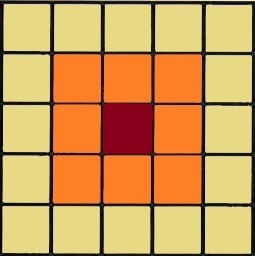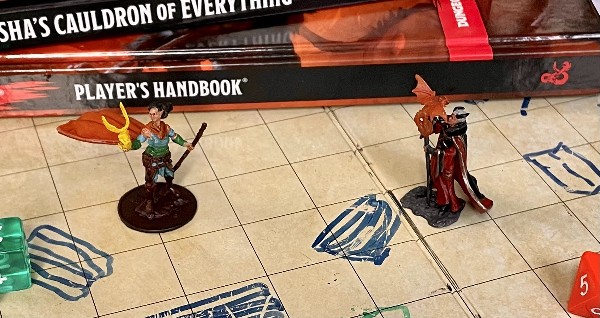As a bonus action, you can move the sphere up to 30 feet. If you ram the sphere into a creature, that creature must make the saving throw against the sphere’s damage, and the sphere stops moving this turn.
When you move the sphere, you can direct it over barriers up to 5 feet tall and jump it across pits up to 10 feet wide. The sphere ignites flammable objects not being worn or carried, and it sheds bright light in a 20-foot radius and dim light for an additional 20 feet.
At Higher Levels. When you cast this spell using a spell slot of 3rd level or higher, the damage increases by 1d6 for each slot level above 2nd.
Casting Time: 1 action
Range: 60 feet
Components: V, S, M (a bit of tallow, a pinch of brimstone, and a dusting of powdered iron)
Duration: Concentration, up to 1 minute
School: 2nd-level conjuration
Player’s Handbook, pg. 242
Flaming Sphere 5e
Flaming Sphere — the less powerful version of Fireball that’s often misunderstood in a multitude of ways. We’ll try to answer the rules questions around this spell as clearly as possible, while also covering some of its best applications in-game.
Who Can Cast Flaming Sphere in 5e?
The following classes have Flaming Sphere on their spell list:
The following subclasses get Flaming Sphere for free:
-
Cleric (Light Domain)
-
Druid (Circle of Wildfire) (TCoE 40)
-
Warlock (The Celestial) (XGtE 54)
-
Artificer (Alchemist) (TCoE 14)
What Does Flaming Sphere Do in 5e?
Flaming Sphere creates a 5-foot-diameter sphere of fire on an unoccupied space that lasts for up to 1 minute, concentration permitting. Any creature that ends its turn within 5 feet of the sphere, takes 2d6 (7 average) fire damage on a failed Dexterity saving throw, or half as much on a success.
Flaming Sphere’s area of effect damage affects 9 total squares (assuming a 5 sq. feet = 1 square), as illustrated below:

Additionally, As a bonus action, you can move the sphere up to 30 feet. If the sphere is rammed into a creature, that creature makes the same saving throw against the sphere’s damage, and the sphere stops moving for this turn. This can be done on every one of your turns while Flaming Sphere remains active.
The sphere can move over barriers of up to 5 feet tall and can jump across pits up to 10 feet wide. It also ignites flammable objects not being worn or carried and sheds bright light in a 20-foot radius and dim light for an additional 20 feet.
What Are the Rules for Flaming Sphere in 5e?
The rules for Flaming Sphere in DnD 5e are as follows:
-
A creature can take damage from Flaming Sphere twice in one round of combat. If a creature is rammed by Flaming Sphere during the caster’s turn, and then remains in range of it until the end of their turn, they will take damage from the spell both times.
-
A creature can walk into, near, and through Flaming Sphere without taking damage. We have Sage Advice confirmation that a creature can walk into/through Flaming Sphere without taking damage.
In other words, Flaming Sphere cannot be used to physically block creatures. And that does make sense logically — Flaming Sphere is a 5-foot sphere, occupying a volume of 65.45 cubic feet. A 5-foot cube occupies 125 cubic feet. Medium and small creatures can definitely limbo their ways beneath the space between the Flaming Sphere and the floor.
A creature can even be shoved into FS without taking damage. As Jeremy Crawford clarifies, Flaming Sphere only does damage “at the end of a turn or when used to ram someone” — at no other time.
-
Flaming Sphere ends beside a creature after ramming it into them. Flaming Sphere does not move onto the space occupied by the creature it rams into; it ends beside the creature, from whichever side it approached.
It’s a little unclear whether a player can end their turn on the same space as Flaming Sphere, but the fact that they can move through its space seems to suggest that they should be able to. However, it is clear that Flaming Sphere must be conjured in an unoccupied space.
-
Flaming Sphere only deals damage when it rams into a creature. Not when it moves past a creature. This means it can only be used to damage one creature per turn when the ram effect is used.
-
Cover from Flaming Sphere is dependent on your location relevant to it. “A target can benefit from cover only when an attack or effect originates on the opposite side of the cover” (PHB 196).
In other words, a creature can get a bonus to their Dexterity saving throw against Flaming Sphere (or avoid its effect entirely) if there’s cover between it and the sphere.
-
Flaming Sphere can be conjured in the air. As this Sage Advice thread puts it, “flaming sphere has no means of flight, yet the spell doesn’t stop you from creating the sphere in the air. If you do, it falls.”
With a 60-foot range, this does open up the possibility of casting Flaming Sphere on a surface above the caster.
-
Allies also take damage from Flaming Sphere. “Any creature” means that allies are also subject to making a Dex save at the end of their turns if they’re in range of Flaming Sphere.
-
Ramming a creture with Flaming Sphere involves the same saving throw and deals the same damage as the spell’s persistent area of effect damage. Clarified in this Sage Advice thread.
-
Flaming Sphere can be moved outside of its initial 60-foot range. “Once a spelll is cast, its effects aren’t limited by its range, unless the spell’s description says otherwise” (PHB 203).
-
You don’t need to see where you move Flaming Sphere. Here’s Sage Advice confirmation that you can use your bonus action to move Flaming Sphere to a space you can’t see.
How Do I Use Flaming Sphere in 5e?
Here are a few ways to use Flaming Sphere in DnD 5e:
-
Trap enemies between Flaming Sphere and allies. While it’s sad that the sphere can’t physically block creatures, there is another way to trap enemies with this spell.
If you position the sphere so that it’s behind enemies who are fighting your melee party members, the enemies will have to make a decision: remain where they are and take fire damage from Flaming Sphere, or move and trigger opportunity attacks from your allies.
Either way, you just increased your party’s damage for the round.
-
Protect an area. If you need to protect an NPC or prevent enemies from standing near something, Flaming Sphere can be a great spell for the occasion. Most creatures don’t like hanging out near/approaching fire if they can help it.
-
Pair with grappling. One of the best ways to consistently trigger Flaming Sphere’s persistent, end-of-turn damage is to have an ally grapple an enemy within range of the sphere. They just have to be careful about how they orient themselves relative to the sphere, to ensure that they don’t take friendly fire.
-
Pair with restraining effects. 16 spells in DnD 5e cause the restrained condition. Entangle, Ensnaring Strike, Snare, Maximilian’s Earthen Grasp, and Web are the level-appropriate spell options that work nicely with Flaming Sphere.
Web is a particularly nice spell to pair it with if you can work with another caster (both spells require concentration). The restrained effect can hold multiple enemies in place near the flames. And when you decide to ram a webbed creature, they’ll take an additional 2d4 fire damage (and be freed from the webs, but hey, still fun).
-
Send it around corners. The fact that you can move Flaming Sphere into spaces that you can’t see is a nice advantage of the spell. Especially if you have allies who do have vision of the battlefield and can help you direct the sphere intelligently.
Another fun tip: If you pair Flaming Sphere with Find Familiar, you can use your familiar to scout ahead for vision. It requires an action to see through your familiar’s vision, and a bonus action to move Flaming Sphere — the perfect combo for a long-distance, remote fireball.
Enemies won’t even know how to react, let alone who to attack. That pandemonium is something your party should be able to take advantage of, even if the spell doesn’t do a bunch of outright damage in the initial assault.
Is Flaming Sphere 5e a Good Spell?
Yes, Flaming Sphere is a good spell. While it can be tricky to consistently land this spell’s area of effect damage, the continuous extra damage at the cost of a bonus action each round is nice. Plus, making good use of positioning can put your enemies between a rock and a…fiery place.
That said, Flaming Sphere can be frustrating to use if the space isn’t conducive to boxing in enemies. Or if enemies and your allies are spread in such a way that it’s not possible to reliably pin foes down.
Flaming Sphere 5e Compared to Fireball
3rd-level Wizards might wonder whether they’re better off skipping Flaming Sphere, what with Fireball becoming available in just two levels. While Fireball is the premier AoE blasting spell for a big chunk of a campaign, it doesn’t make Flaming Sphere completely useless.
For starters, Flaming Sphere has a 1-minute duration and can be used to control the battlefield, force enemies into difficult decisions, and make safe attacks from around corners. Not to mention that, if used for the full duration against enemies who can’t move, Flaming Sphere can easily out-damage Fireball overall.
That being said, Fireball’s massive area of effect, range, and upfront damage are still attractive. If you’re looking for the better straight-up damage spell, Fireball wins. If you want more nuance and control, go with Flaming Sphere.
Picking both isn’t the best idea, since they’re both fire spells with Dexterity saves. Unless you’re building a fully thematic fire mage — then it’s a great idea.
Simple Flaming Sphere 5e Spell Text
As a bonus action, you can move the sphere up to 30 feet. If you ram the sphere into a creature, that creature must make the saving throw against the sphere’s damage, and the sphere stops moving this turn.
The sphere can maneuver over barriers up to 5 feet tall and jump across pits up to 10 feet wide. It ignites flammable objects not being worn or carried, and it sheds bright light in a 20-foot radius and dim light for an additional 20 feet.
+1d6 fire damage per slot level above second
How Other Conjuration Spells Work in DnD 5e
D&D Create Bonfire
D&D Infestation
D&D Mage Hand
D&D Sword Burst
D&D Entangle
D&D Find Familiar
D&D Ice Knife
D&D Cloud of Daggers
D&D Healing Spirit
D&D Misty Step
D&D Web
D&D Call Lightning
D&D Sleet Storm
D&D Spirit Guardians

![Spike Growth 5e [DnD Spell Guide: Uses, Rules, Tips] entangle-5e-druid](https://www.dndlounge.com/wp-content/uploads/2022/03/entangle-5e-druid-300x174.jpg)
![Shillelagh 5e [DnD Spell Guide: Uses, Rules, Tips] owlbear-dnd-5e](https://www.dndlounge.com/wp-content/uploads/2022/03/owlbear-dnd-5e-300x218.jpg)
![Shape Water 5e [DnD Spell Guide: Uses, Rules, Tips] dnd-5e-character-sheet-and-die](https://www.dndlounge.com/wp-content/uploads/2022/03/dnd-5e-character-sheet-and-die-300x157.jpg)
![Aura of Vitality 5e [DnD Spell Guide: Uses, Rules, Tips] dungeons-and-dragons-party-vs-blue-dragon](https://www.dndlounge.com/wp-content/uploads/2022/03/dungeons-and-dragons-party-vs-blue-dragon-300x223.jpg)